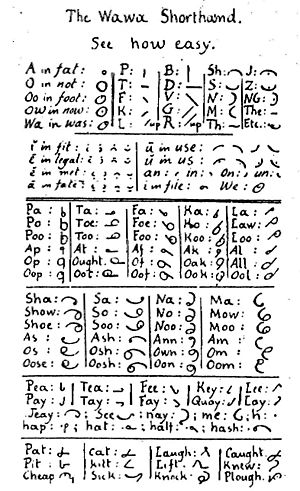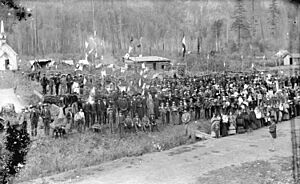Kamloops Wawa facts for kids
The Kamloops Wawa (which means "Talk of Kamloops" in Chinook Jargon) was a special newspaper. It was started by Father Jean-Marie-Raphaël Le Jeune in British Columbia, Canada. The first issue came out on May 25, 1891. This newspaper was unique because it was almost entirely written using a special shorthand system. Father Le Jeune created this system, called "chinuk pipa," from a French shorthand style.
Most of the newspaper was written in a local version of Chinook Jargon. Some parts also used other traditional languages like Nlaka'pamuxtsin, Secwepmectsin, and St'at'imcets. The Kamloops Wawa shared community news and religious texts. It even included translations of old Latin stories, like the Seven Kings of Rome.
How the Chinook Writing System Started
In June 1890, a group of missionaries met in New Westminster. They talked about how hard it was to write First Nations languages. The writing system they used for the Carrier people didn't work well for other languages in British Columbia.
Father J. D. Chiappini suggested using shorthand. He thought it would be good for both European and Indigenous languages. In August, Father Le Jeune went back to the Kamloops area. He tried to teach this new writing system to local people.
At first, his efforts didn't work very well. But then he visited Coldwater, near Merritt. There, a man named Charlie Alexis Mayous started to learn with great effort. Father Le Jeune left Mayous with a notebook of lessons and prayers. When Le Jeune returned in December, Mayous had learned the shorthand completely. He could read French and English as well as his own language. Mayous then began teaching other Indigenous people this new "Chinook writing."
Before Christmas, Le Jeune and Mayous traveled to Douglas Lake. Mayous taught the shorthand there, and people were very eager to learn. They even sharpened Le Jeune's pencils so he wouldn't have to stop writing. After Christmas, the people of Douglas Lake wanted Mayous to stay. But the people from Coldwater wanted him back. Le Jeune returned to Coldwater around Easter. He found that Mayous had taught everyone the shorthand. Everyone could now read their prayers in the Thompson language.
Early Days of the Kamloops Wawa Newspaper
Father Le Jeune was very successful at teaching the shorthand. However, it was hard for him to create enough teaching materials while also doing his church duties. In February 1891, he tried using a hectograph to make copies. This worked fairly well. In March, he saw an ad for an Edison mimeograph machine and ordered one right away.
On May 25, Father Le Jeune published the first issue of the Kamloops Wawa. But he only printed a few issues before stopping it. Not enough people subscribed to the newspaper.
In July 1891, many First Nations people gathered in Kamloops. They saw that the people from Coldwater and Douglas Lake could write down songs they didn't know. This made a big impression. After this gathering, Father Le Jeune was sent to the Shuswap people. They were impressed by the writing skills of the Thompson people. They wanted to learn the shorthand too. Within two months, most of these people could read almost anything written in Chinook Jargon or Shuswap. That fall, Le Jeune kept teaching the shorthand in every village he visited. He used actual Chinook texts, like Bible verses and hymns, instead of just practice lessons.
With so many people eager to learn, Le Jeune started printing the Kamloops Wawa again. The first new issue came out on February 2, 1892. He started with 25 copies, then increased to 100, then 150, 200, and finally 250 copies. By the end of that year, as many as 300 copies of each newspaper were being printed.
In 1893, Monsignor Durieu translated the Old Testament into Chinook Jargon. Copies of this text were included as a 16-page extra each month with the Kamloops Wawa. The newspaper also printed prayers in Latin, Chinook, Thompson, and Okanangan.
See also
- Duployan shorthand
- Duployan (Unicode block) and Shorthand Format Controls (Unicode block)
- Chinook Jargon
- Canadian Aboriginal syllabics



